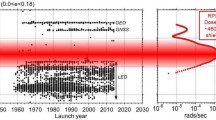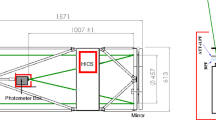Abstract
The CEPPAD Experiment consists of four sensors for investigating energetic particle phenomena on the POLAR mission. These sensors provide 3-D proton and electron angular distributions in the energy range of 20 keV to 1 MeV, energetic proton and electron measurements extending to energies greater than 10 MEV, high angular and time resolution measurements in the loss-cone, and data on energetic neutral particles. All sensors operate in conjunction with special on-board data processing units which control sensor data acquisition modes while performing in-flight data processing, data compression, and telemetry formatting. Presented here is a CEPPAD system overview together with descriptions of the individual sensors, the in-flight data processing, and examples of sensor calibration data.
Similar content being viewed by others
Author information
Authors and Affiliations
Rights and permissions
About this article
Cite this article
Blake, J.B., Fennell, J.F., Friesen, L.M. et al. CEPPAD. Space Sci Rev 71, 531–562 (1995). https://doi.org/10.1007/BF00751340
Received:
Issue Date:
DOI: https://doi.org/10.1007/BF00751340




